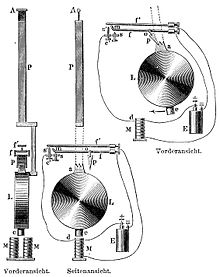Precision pendulum clock

left: "Type A" with air pressure compensation
right: "Type D" in a glass cylinder

The precision pendulum clock (PPU) is a stationary wheel clock that was built as a time standard for time service purposes and astronomical observations . In it, the highest possible accuracy of a clock in the 19th and 20th centuries was achieved.
The purely mechanical precision watch was perfected by Sigmund Riefler (1847–1912) and, on the basis of two patents ( Riefler pendulum and gravity escapement ), it was increased to an accuracy of less than a tenth of a second per day. Ludwig Strasser achieved similarly good timing results with the Strasser escapement he developed .
As a time standard, Riefler clocks were built until around 1965 and then replaced by even more precise quartz clocks .
Pendulum clocks, whose pendulums were driven electrically rather than by an escapement , were developed by Matthäus Hipp and William Hamilton Shortt (1881–1971) , among others . The Shortt clock from 1921 even achieved 0.01 s / day thanks to two synchronized pendulums and their electrically controlled friction compensation . The disadvantage of these concepts was that the drive pulse was triggered electrically, but was still transmitted mechanically to the pendulum (Shortt) or triggered mechanically by the pendulum and had an electromagnetic effect on it (Hipp). A really free pendulum oscillation was not given in this way.
Maximilian Schuler solved the problem with his electromagnetically driven Schuler pendulum , which synchronized a (mechanical) work clock from Riefler via a light barrier, which in turn triggered electrical drive pulses for the Schuler pendulum. The impulses were transmitted to a stationary coil, the electromagnetic field of which acted on a permanent magnet attached to the pendulum.
The precision pendulum clocks (mechanical or electrical) used in observatories around the world were dominated by the manufacturers Strasser & Rhode (Glashütte), Riefler (Nesselwang and Munich), Schuler (Göttingen) and Shortt (England).
Electric pendulum clocks, however, could not establish themselves on a larger scale, because the electrical and electronic components available at that time (1930s and before) did not have the necessary reliability and the clocks were therefore much more maintenance-intensive than the purely mechanical ones.
criteria
The construction of this type of clock had to meet the following criteria:
- High quality work
- High quality escapement
- Compensation of the gear regulator
- low bearing friction, evacuated housing
- Clear display of the second
- Long running time
history
England and France promoted the natural sciences as early as the 17th century through their scientific societies ( Royal Society and Académie des sciences ) and disseminated their results promptly in journals so that innovations were quickly known and implemented. In this way, in the second half of the 18th century, the two nations competed as leading seafaring nations in the manufacture of precise clocks.
Although all inventions in the watch sector became known through publications in Germany, modern techniques were only applied here with a long delay. On the one hand the political situation ( Thirty Years War ), on the other hand the traditional attitudes and the strict guild regulations in watchmaking centers such as Augsburg and Nuremberg played a major role. The technical breakthrough in Germany did not come until the beginning of the 19th century. In the first half of the 20th century, one of the most precise pendulum clocks in the world was built in Germany.
The decline of precision pendulum clocks came in the second half of the 20th century with the invention of the quartz clock, the accuracy of which was three powers of ten better.
Precision pendulum clocks are still made today for collectors and enthusiasts. There are also those with an extra-long 1¼-second pendulum (1.7 m) that swings only four times in 5 seconds.
literature
Erbrich, Klaus: Precision pendulum clocks: from Graham to Riefler ; Callwey Verlag; Munich 1978; ISBN 3-7667-0-429-X
Web links
- watch-wiki: precision pendulum clock
- Clock cabinet of the Staatliche Museen Kassel: precision pendulum clock in a pressure-tight tank
Individual evidence
- ↑ Ermert Jürgen: To early German precision pendulum clocks ; Ebner Verlag Ulm; Klassik Uhren 4/2009 p. 10f
- ↑ Rediscovery and repair of the precision pendulum clock Riefler No. 711
- ^ WH Shortt: An Improved Mechanism for Impelling Pendulums or Balance Wheels. Retrieved on June 6, 2019 (click on "Load full document" after calling up).
- ↑ WH Shortt: imrovements in the synchronization of clocks. Retrieved on June 6, 2019 (click on "Load full document" after calling up).
- ↑ M. Hipp: Innovations in electrical clocks. Retrieved on June 6, 2019 (click on "Load full document" after calling up).
- ^ Disk, Adelsberger. Physicist and watchmaker from Germany. Retrieved June 14, 2019 .
- ^ Eva Grois: The Augsburger Uhrmacher-Handwerk ; Editors: Maurice and Mayr; “The world as a clock”; German art publisher; Munich Berlin 1980; P. 63f; ISBN 3-422-00709-1
- ^ Riefler, Dieter: Riefler precision watches: 1890-1965 ; Callwey Verlag; Munich 1991; ISBN 3-7667-1003-6
- ^ Kummer, Hans-Jochen: Ludwig Strasser: a clock specialist from Glashütte; Precision clocks from Saxony ; Callwey Verlag; Munich 1994; ISBN 3-7667-1122-9
- ^ Precision pendulum clocks from Erwin Sattler
- ↑ Naeschke grandfather clock NL 125